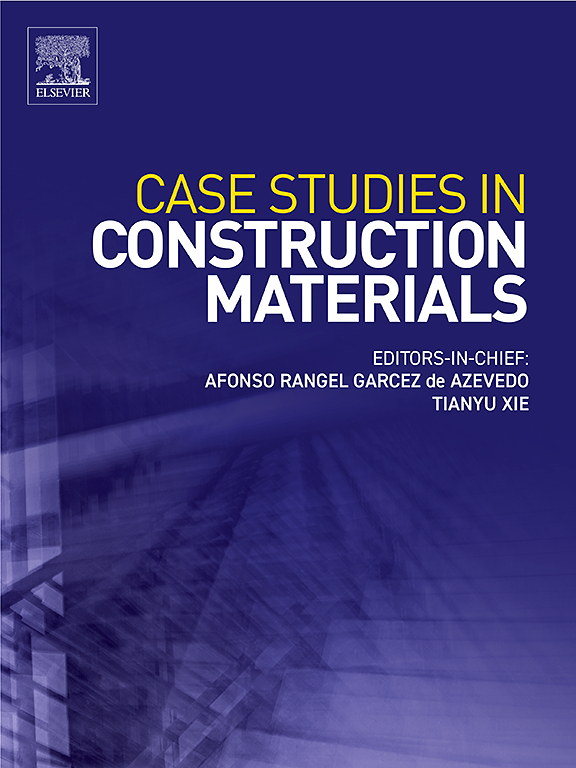用于耐用大块木板的热改性木股和薄单板的性能
IF 6.6
2区 工程技术
Q1 CONSTRUCTION & BUILDING TECHNOLOGY
引用次数: 0
摘要
本研究中提出的创新结构复合材料,通过采用基于链的技术,为低价值、小直径树木的生产提供了重新利用的机会。此外,木链的热改性为化学处理提供了一种天然的替代方案,确保了尺寸稳定和耐用的大量木材产品的生产。在本研究中,为了证明热改性工艺的规模扩大,在工业高压灭菌器中评估了热改性(TM)木链在不同温度和压力下的机械和物理性能,并评估了它们在生产薄木链单板复合材料中的功效。低档云松冷杉木材的木链在165℃、170℃和180℃的峰值温度下进行热改性,恒定压力为1.4 MPa,在165℃下恒定压力为0.8 MPa。在这些条件下,所有处理的停留时间均为2 h。该过程是使用氮气的工业高压灭菌器(12 m3体积)进行的。结果表明,在0.8 MPa和165℃条件下,得到了质量和性能都适合制作复合板的钢绞线。在半纤维素降解和部分提取的作用下,处理后的纤维的平衡含水率降低了35% %,接触角增加了21% %,拉伸模量没有显著变化,拉伸强度降低了52% %,脆性指数提高了91% %。TM木链生产的单板具有更好的粘结性能和尺寸稳定性,其中厚度膨胀减少了38% %,内部粘结强度增加了37% %,弯曲刚度没有显著变化,弯曲强度降低了37% %,而单板的脆性指数增加了54% %。本文章由计算机程序翻译,如有差异,请以英文原文为准。
Performance of thermally modified wood strands and thin veneers for use in durable mass timber panels
The innovative structural composite material, proposed in this study, offers an opportunity to repurpose low-value, small-diameter trees by adopting strand-based technology into their production. Furthermore, the thermal modification of wood strands provides a natural alternative to chemical treatments, ensuring the production of dimensionally stable and durable mass timber products. In this study, to demonstrate the scaling up of the thermal modification process, the mechanical and physical performance of thermally modified (TM) wood strands subjected to varying temperatures and pressures in an industrial autoclave were evaluated, and their efficacy in producing thin wood-strand veneer composite materials was evaluated. Wood strands from low-grade spruce-pine-fir lumber were thermally modified at peak temperatures of 165°C, 170°C, and 180°C, keeping a constant pressure of 1.4 MPa, and at 165°C with 0.8 MPa. A dwell time of 2 h at these conditions was used in all treatments. The process was conducted using an industrial autoclave (12 m3 volume) with nitrogen gas. Based on the results, the treatment at 0.8 MPa and 165°C yielded strands with suitable quality and performance to produce composite panels. Driven largely by hemicellulose degradation and their partial extraction, a 35 % reduction in the equilibrium moisture content and 21 % increase in contact angle of the treated strands was observed along with no significant variation in tensile modulus, about 52 % reduction in tensile strength, and 91 % increase in brittleness index. TM wood strands produced veneers with improved bond performance and dimensional stability, where a reduction in thickness swelling of up to 38 %, an increase in internal bond strength by 37 %, no significant variation in flexural stiffness, a decrease in flexural strength by 37 %, and an increase in brittleness index by 54 % in the veneers were observed.
求助全文
通过发布文献求助,成功后即可免费获取论文全文。
去求助
来源期刊

Case Studies in Construction Materials
Multiple-
CiteScore
7.60
自引率
19.40%
发文量
842
审稿时长
63 days
期刊介绍:
Case Studies in Construction Materials provides a forum for the rapid publication of short, structured Case Studies on construction materials. In addition, the journal also publishes related Short Communications, Full length research article and Comprehensive review papers (by invitation).
The journal will provide an essential compendium of case studies for practicing engineers, designers, researchers and other practitioners who are interested in all aspects construction materials. The journal will publish new and novel case studies, but will also provide a forum for the publication of high quality descriptions of classic construction material problems and solutions.
 求助内容:
求助内容: 应助结果提醒方式:
应助结果提醒方式:


